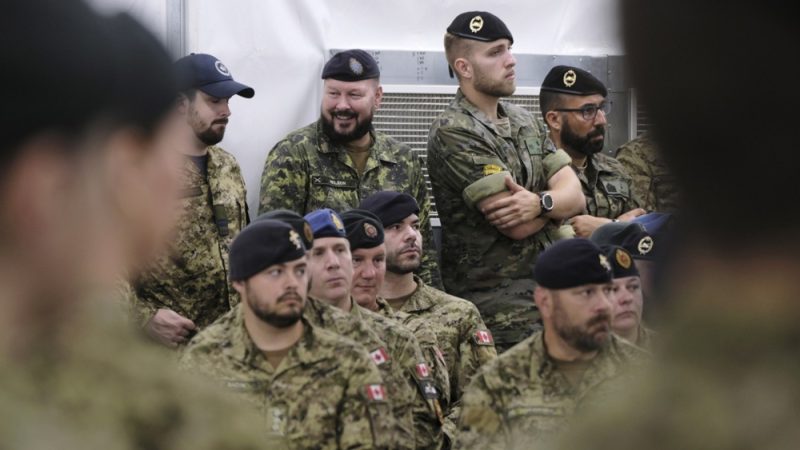
Eastern Europe’s army battles to find young individuals willing to fight for not far away conflict
Dozens of pupils engaged in a trial Czech army program designed to increase declining enrollment rates crawl through woodland underbrush while learning appropriate shooting techniques, all as instructors yell orders.
Similar to the majority of former Soviet satellite nations currently part of NATO, the Czech Republic has had years of difficulties meeting military numbers and recruiting goals. Due to this, army units are undermanned and incapable of being prepared for conflict, and Russia’s invasion of Ukraine, which is on the periphery of eastern Europe, serves as a clear warning of Moscow’s possible danger to the area.
About eighty Czech high school students made the decision to spend a portion of their summer at the four-week training program, which is being held in a closed military zone located 94 kilometers (58 miles) west of the country’s capital, Prague, learning about army life.
However, the head of the Czech armed forces, General Karel Rehka, has declared the existing structure unworkable.
According to him, Reuters, kids get an early taste of army life through the program conducted by the 4th Rapid Deployment Brigade, an army force that is only operating at 50% of its potential owing to a shortage of personnel.
“We want to deter any potential adversary in the future,” Rehka stated. “If we don’t do anything about the lack of human resources in the military…, it may mean that we won’t be able to preserve our peace and to deter any potential enemy.”
According to the most recent army data, the Czechs recruited 56% of their target in 2021 and increased that percentage to 85% in 2022.
Czechs are not the only ones. In an area that shares borders with Ukraine, Poland, Hungary, Romania, and Slovakia, nations in eastern Europe have struggled to enlist new soldiers and retain those with experience.
“We cannot do anything without people – if we modernise equipment and don’t have enough competent people and motivated people, that is all wasted money,” Rehka stated.
A EUROPEAN-WIDE ISSUE
NATO members from Western Europe deal with comparable issues. NATO would require an additional 35 to 50 brigades to adequately implement its revised plans to fight against any Russian invasion on alliance territory, according to a July Reuters report.
However, the issue is more personal for the eastern European nations that were ruled by the Soviet Union for forty years and have long been aware of the threat posed by a more powerful Russia led by President Vladimir Putin.
Prague’s ambassador on topics related to Ukraine’s rebuilding, Tomas Kopecny, a former deputy minister of defense for the Czech Republic, told Reuters that “we also see the probability of Russian aggression against us as not impossible…within a few years.”
“So in case Russia attacks, we need to know we can count on a certain amount of soldiers and capabilities.”
Governments have shifted to digital marketing efforts, increased recruitment bonuses, and explored alternatives such as an order from the Czech defense ministry that, as of September 1, lowers the medical standards for reservists, career soldiers, and recruits.
Convincing young people to enlist for less money than they can make in the private sector is a significant task, though, given unemployment rates are low throughout eastern Europe.
“We have difficulties. First Deputy Chief of Staff of Poland’s armed forces, Major General Karol Dymanowski, told Reuters that they had to do with the country’s extremely competitive labor market.
NEED FOR A NEW GENERATION OF SOLDIERS
Although government and military authorities in Poland claim to be meeting their recruitment objectives and want to raise the cap, others doubt the viability of their goal of amassing a 300,000-strong army.
The largest nation in Eastern Europe also wants to increase defense expenditure to over 5% of GDP. To that aim, it has started a recruiting drive called “Holidays With the Army,” which offers 28 days of basic military training to residents between the ages of 18 and 35.
However, despite an increase in recruitment in the most recent numbers available, according to data from the defense ministry, 9,000 professional soldiers left the military in 2023, setting a record.
Colonel Bogdan Sowa, chief of Organization and Recruitment Directorate in Poland’s General Staff, clarified that a significant portion of soldiers quit the army within a few years after enlisting, despite Dymanowski’s assertion that it is a “natural process”. “We are working to create new financial incentives and more appealing offers for them,” Sowa stated.
The military in Hungary has started a media effort to attract new troops, including billboards, ads, and a TV series with a military theme that will air by the end of 2024. The military has not released current recruiting figures.
The government of Romania launched recruitment campaigns when newly released statistics from the ministry of defense revealed that 23% of soldier and other professional ranks, as well as 43% of officer posts, remained vacant.
Only two of Romania’s four Patriot missile defense batteries are in service, and the country has purchased many F-16 fighter planes but does not have enough qualified pilots to operate them.
According to a defense source who spoke to Reuters, “one must look at what laws need to be changed, not only in Romania but in other countries, to incentives these people (serving soldiers) to stay.”
Romania and other nations are looking forward to a new generation of warriors, such as John Dunka, a high school student from the Czech Republic who is now attending the army’s summer camp close to Prague and intends to serve after graduation.
Taking a break from military training, Dunka commented, “Wearing this uniform includes a sense of pride.” He was clutching an empty Bren 2 battle weapon. “With all that has happened in the world, I’m glad I can participate in a camp like this.”
All Categories
Recent Posts
Tags
+13162306000
zoneyetu@yahoo.com



